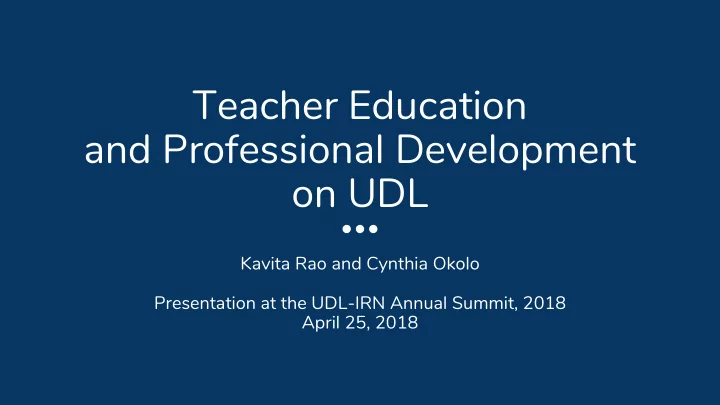

Teacher Education and Professional Development on UDL Kavita Rao and Cynthia Okolo Presentation at the UDL-IRN Annual Summit, 2018 April 25, 2018
Today’s presentation • S ummary of literature on teacher education and UDL •Approach for teaching pre- and in-service teachers how to use UDL Presentation Digital Handout: goo.gl/RqaYoH
Teacher Education Literature •Search: EBSCO, ERIC • UDL OR Universal Design for Learning AND Teacher Education OR Teacher Preparation • 2000-2017 • Peer reviewed • K-12 learners • Larger UDL dataset (Okolo & Diedrich)
Results of Search • 32 papers Explicitly addressed preparation of teachers to use UDL with K-12 learners Many others had implications for TE (not included) • 19 papers identified as research 22 studies
Highlights • Variety of educators; primarily undergrad and practicing teachers • Number of participants and duration highly variable • n = 3 to 98; time = one 1-hour session to over 18 months • Most common variables measured • Knowledge and skills, lesson design •
Highlights • Most common measures: surveys, questionnaires, participant products, and interviews • Several studies included classroom observation for occurrence/nonoccurrence of principles or technology use. • Over half of the studies used posttest only designs
Conclusions • TE and UDL literature is limited 228 papers (Okolo & Diedrich) vs 32 papers directly addressing teacher education • No consensus about effective TE practices Variety of approaches, features, duration, audiences About 25% of these studies used UDL as a framework for other practices
Most promising evidence.. For approaches that included lesson design Participants able to effectively plan lessons that include UDL principles
An approach for teacher education How can I get my students to learn about and use UDL in a meaningful way?
An approach for teacher education Knowledge about what UDL is + Skills on how to use UDL
Essential Knowledge & Skills Knowledge: •What the UDL framework is •The principles/guidelines/checkpoints Skills: •How can I use these 31 checkpoints? •How can I design for variability?
UDL Skills Guiding principles for teacher educators: 1. UDL is about design 2. UDL should be applied proactively 3. UDL provides a way to design for learner variability.
Guiding principle for teacher educators 1. UDL is about design Teachers as instructional designers
Guiding principle for teacher educators 1. UDL is about design Teachers as instructional designers Put planning first with UDL as a tool
Guiding principle for teacher educators 2. UDL should be applied proactively •Plan from the outset •Contrast to differentiation •Use incrementally
Guiding principle for teacher educators 3. UDL provides a way to design for learner variability. Consider: • your learners as a first step • barriers, preferences, and needs
4 components of lessons •Goals •Assessments •Methods •Materials
UDL Design Cycle Rao & Meo, 2016
UDL Design Cycle Step-by-step process of bringing together SKILLS and KNOWLEDGE Rao & Meo, 2016
UDL Design Cycle Illustrates how components are interrelated and how UDL can fit. Rao & Meo, 2016
Example: UDL applied to a classroom lesson/unit
Scenario 1: Classroom example of middle school math lesson
Standards-based lesson CCSS.Math.Content.8.EE.C.7b Solve linear equations with rational number coefficients, including equations whose solutions require expanding expressions using the distributive property and collecting like terms . Skills Concepts
Unwrap this standard What are the skills and concepts in this standard: CCSS.Math.Content.8.EE.C.7b Solve linear equations with rational number coefficients, including equations whose solutions require expanding expressions using the distributive property and collecting like terms . Skills Concepts Solve linear equations Rational number coefficients Use distributive property Collect like terms
Step 1: Consider Barriers, Preferences, Needs Specific: • Challenges w/ concepts and vocabulary • Difficulty with step by step process General: • Anxiety with math Source: • Boredom, disengagement http://www.tbo.com/pasco-county/middle-schoolers-rack-up-high-school-credits-20130 920/ Preferences • Social vs. independent • Write vs. talk
The idea
Step 2: Develop goals Students will: • Practice solving linear equations • Use the vocabulary of math in context • Think aloud when problem solving
Step 3: Assessment Formative: • Development of step-by-step explanation Summative: • Audio/video explanation (using Educreations)
Step 4: Methods and Materials Methods: • Modeling (authentic) • Clear expectations/self guidance • Practice opportunities • Partners/Individual Materials: • Multimodal tool • Checklist
Clear expectations
One pair’s project Acknowledgement: Thank you to Mr. Naohito Miura
Learning process… What barriers did this process remove/reduce? Source http://smmercury.com/2012/04/18/travis-dezavala-students-to-be-issued-ipads-kindle-fires/
UDL Checkpoints and Lesson Components Connections with UDL UDL Lesson Component Checkpoints Goals Practice solving linear equations Use the vocabulary of math in context Think aloud when problem solving Assessment Formative: Process of developing projects in collaboration with others 4.1, 5.2, 5.3, 6.1, Summative: Audio/video project (on Educreations) 6.2, 8.3 Methods 2.1, 2.3, • Modeling (authentic) 3.1, • Clear expectations/self-regulation 5.3, • Authentic output 6.2, • Opportunities to practice 7.1, • Various ways to express 8.1, • Work in different formats (partners/individual) Materials 4.1, • Multimodal tool 5.1 • Rubric/Checklist 9.1
Applying process to planning For various purposes: • Co-teaching • Unit and lesson planning • Grade level teams • Project-based learning
Resources Israel, M., Ribuffo, C., & Smith, S. (2014). Innovation Configuration Universal Design for Learning Recommendations for Teacher Preparation and Professional Development. Office of Special Education Programs, U.S. Department of Education , (Ic), 1–38. Meo, G. (2008). Curriculum planning for all learners: Applying Universal Design for Learning (UDL) to a high school reading comprehension program. Preventing School Failure: Alternative Education for Children and Youth , 52 (2), 21–30. doi:10.3200/PSFL.52.2.21-30 Meyer, A., Rose, D. H., & Gordon, D. T. (2014). Universal design for learning: Theory and practice . Wakefield, MA: CAST Professional Publishing. Rao, K., & Berquist, E. (2017). A co-teaching conversation: Using Universal Design for Learning (UDL) to plan lessons together for the inclusive classroom. In E. Berquist (Ed.), UDL: Moving from exploration to integration (pp. 121-138). Wakefield, MA: Center for Applied Special Technology. Rao, K., & Meo, G. J. (2016). Using universal design for learning to design standards-based lessons. Sage Open , 6 (4), 1-12. doi:10.1177/2158244016680688
Questions/Comments Kavita Rao kavitar@hawaii.edu Cynthia Okolo okolo@msu.edu Presentation Handout: goo.gl/RqaYoH
Recommend
More recommend